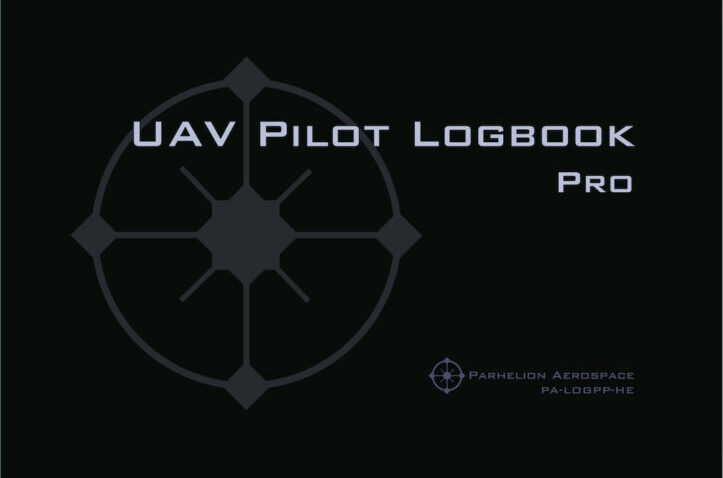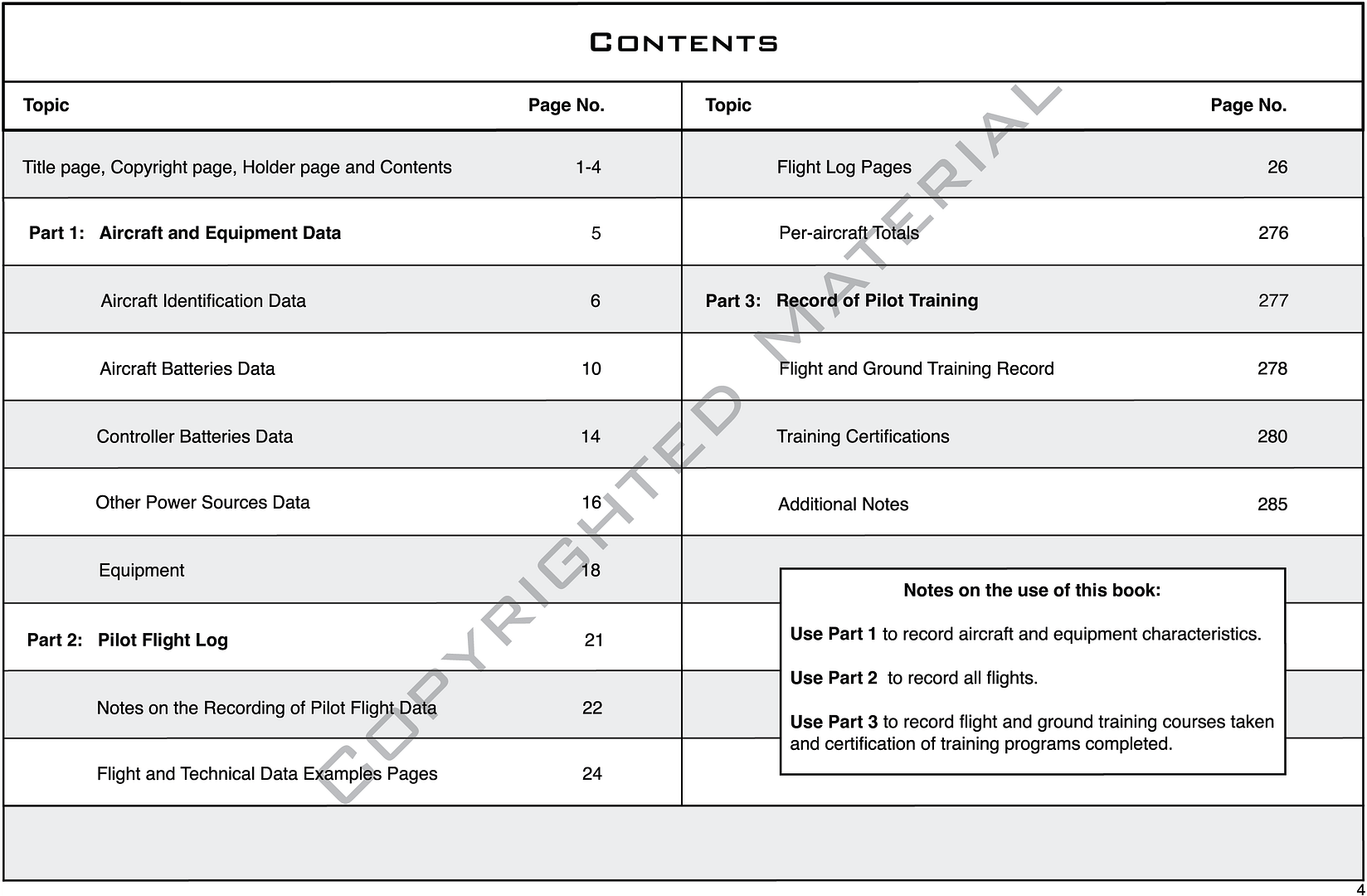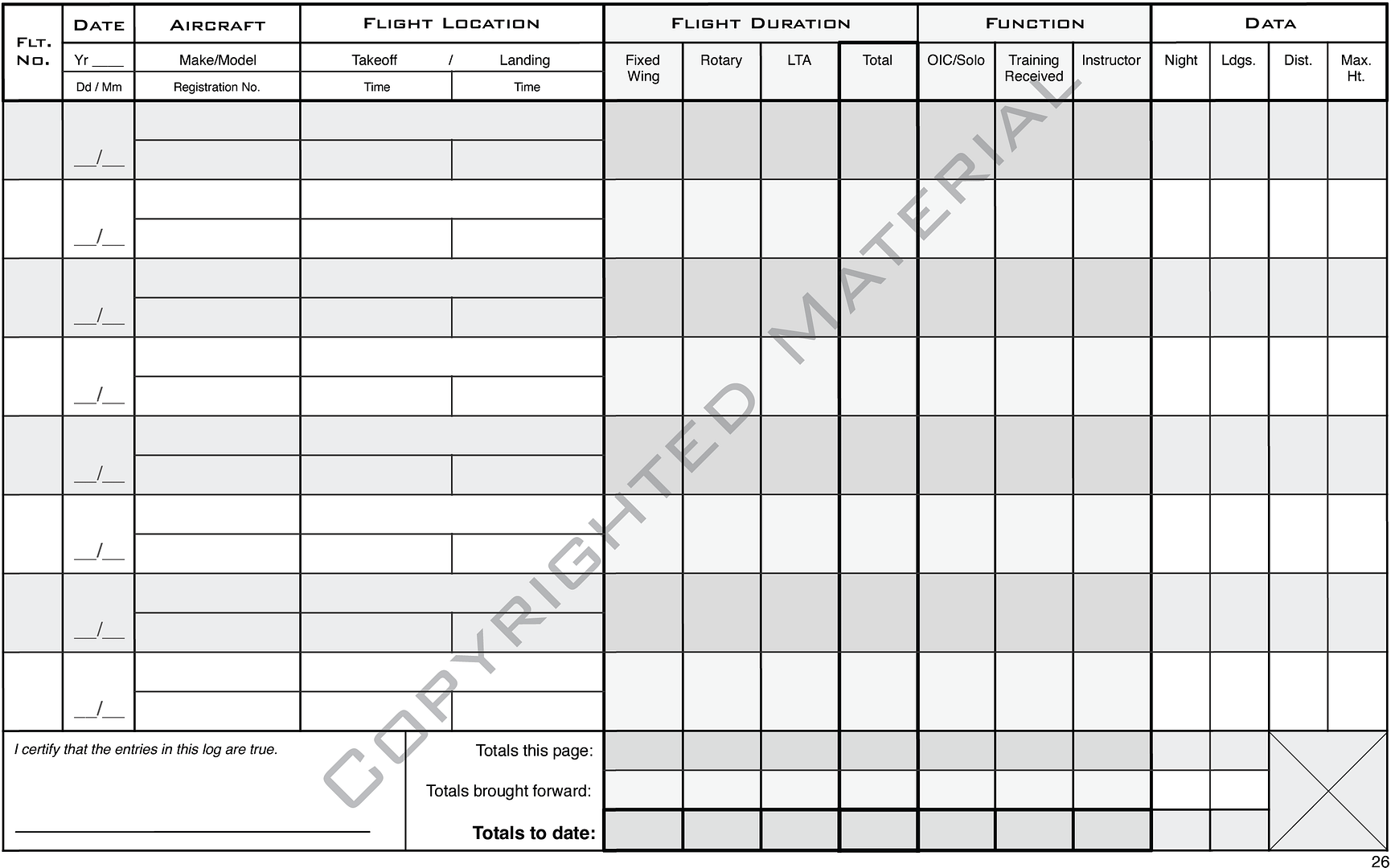Use drone pilot logbooks to record your UAV flights.
You are a serious, possibly commercial, drone pilot and you want to run your drone program professionally. You routinely use all of the tools necessary to achieve that goal – but have you considered using drone pilot logbooks to make proper records of your flying experience? You ought to, for the sake of demonstrating your experience and professionalism.
In this Parhelion Article we will explain what drone pilot logbooks are and what they are not. We will discuss how using a pilot logbook benefits you, what it should consist of, and how to tell a good one from a bad one. Let’s take a look!
What are “drone pilot logbooks?”
Drone pilot logbooks are, or should be, derived from standard (piloted)-aviation pilot logs. These date back to the first days of flight; as early as 1912, for example, the British Royal Flying Corps recorded military flight data in logbooks. Although the early logbooks tended to combine pilot and aircraft (technical) data, the practice of logging flying experience in particular soon became mandatory for professional pilots.
In the case of modern aviation, therefore, the purpose of a pilot logbook is to record the history of an individual pilot’s flying activities, rather than to record in detail aircraft performance and technical data. In fact, a pilot’s logbook may reflect the use of several different aircraft over time, depending upon the opportunities of the aviator. As such, it is a personal reflection of the experience of an individual, potentially encompassing all that he or she may have flown.
Such a book has traditionally been divided into parts, or sections, that are put to different uses. The logbook “Holder” (the pilot) is identified in the first part, and information about his or her licenses and qualifications is included. The flight data section, which is the longest part of the book, follows. In this part, separate areas on a page (or two) are provided in which to record all significant data that characterized a given flight. A final section then normally ends the book, in which details about training courses and exams taken by the Holder may be recorded, often with places for examiners to sign to demonstrate that the he or she did pass the exam.
It is appropriate and valuable for drone pilots to use such a logbook as well – the benefits of doing so will be explained below. The thing to keep in mind is that, just as UAVs and jet aircraft differ in their flying purposes, so does a drone pilot logbook differ from the logs that record the activities of standard-aircraft pilots. Just what ought to be present in a dedicated drone pilot logbook will be explained in this article, too.
They are not “aircraft logbooks.”
Pilot logbooks are not the same as aircraft logbooks. Drone aircraft logbooks, which we have described in an earlier Article, record the flight data of an individual machine’s use history and technical status. As stated above, a pilot logbook is clearly not dedicated to a single machine, but instead may, and over time likely will, record data from the use of several different aircraft, depending upon the pilot’s opportunities.
A pilot logbook is concerned primarily with operational information, such as flight locations and durations, as well as personal factors such as whether the flight was instructional or otherwise. It reflects the totality of the pilot’s flying experience and, even though a minor amount of aircraft technical data may be recorded, its focus is on the pilot, not the machine.
What are the benefits of using a drone pilot logbook?
The fact is, neither the FAA nor EASA have published specific requirements concerning the logging of drone flights. Nevertheless, you benefit from logging certain flight data and should, therefore, do it even if the civil aviation authority does not require it.
The purpose and chief benefit of keeping a detailed drone pilot logbook is that it provides the pilot with a tangible record of flying experience. A well-made pilot logbook, as described below, will not only present the owner’s experience in its totality but in its variety too. For example, a well-kept logbook shows not only how much flight time the owner has, but what sorts of flying were done, e.g. training flights, flights as instructor, night flights, flights employing various kinds of sensors, etc. Filled with such data, a drone pilot logbook is a valuable asset that can help to legitimize a pilot’s claims of experience for any employer or client who asks. A logbook is therefore an essential companion to the commercial drone pilot, in particular.
This same issue of pilot ability is further addressed by logging UAV flight-related training, even if done as an academic, “ground school” course. A proper pilot logbook ought, therefore, to include the ability to log the details of formal courses of instruction, particularly those that have exams and that result in licenses, certifications or exemptions from restrictions. Such a record provides valuable proof of professionalism and competence.
Additionally, by recording any events that may have occurred during the day’s flights (e.g. malfunctions, crashes, etc), as well as logging any pre-flight safety precautions taken (e.g. pre-flight aircraft inspections, etc), a pilot’s logbook becomes a statement of professional safe practices. As such, it may come in handy as evidence on the side of the aviator if he or she is confronted by the authorities regarding the events of a given flight. It’s good to have a written record that demonstrates the legality and safety of your proceedings!
Further, keeping an up-to-date drone pilot logbook may assist in obtaining a lower price on drone insurance, since insurance providers may be inclined to take flight experience into consideration when determining rates. The pilot log can thereby potentially pay for itself, in terms of savings gained, through being able to provide the insurance company with proof of your safe flying experience.
Also, for pilots flying under FAA part 107, it is useful to provide the agency with copies of your flying experience (e.g. logbook pages) whenever applying for waivers under that regulation, to demonstrate your level of experience and expertise.
Finally, there is always, of course, the sheer satisfaction that comes from seeing with your own eyes the record of your experience and how it is increasing over time. This applies to private, or hobbyist, flyers, just as much as it does to commercial ones.
Don’t forget the money, either.
If you were to think of this in terms of income, for those of you who fly commercially, how would it feel to lose a job worth several thousand (Dollars, Euros, Swiss Francs) to a competitor who DID keep such a logbook and who had it on hand to validate himself to the prospective client? In the competitive environment in which we operate it is smart to gain every advantage that you can; this is one that is well within your grasp.
As additional considerations, even though a pilot logbook is essentially about the pilot’s experience, for those who own the drone(s) they fly using a logbook to keep track of basic technical factors such as aircraft age, amount of use and technical history (to include damage occurrence) may directly affect dollar items such as insurance and resale value, and when dealing with these it is always to your advantage to have accurate records to show. This applies to both commercial and private UAV operations.
Of course, strictly speaking such data are best recorded in a drone “aircraft” logbook, which we have described in an earlier Parhelion Guide Article. Some more comprehensive pilot logbooks, however, may present the opportunity to record some basic aircraft technical data in addition to the pilot’s flight data. This becomes challenging to keep straight, however, as soon as the pilot flies more than one type of aircraft – more on this below.
What are the drawbacks?
Filling out logbooks takes time and discipline. You have to be careful and diligent. We take this as a sign of a pilot’s degree of professionalism, however.
Furthermore, properly-designed, dedicated UAV pilot logbooks, are uncommon. Many of the drone pilot logbooks that are available today are poorly designed. They show little understanding of the necessary elements of aviation data logging, especially where professional or commercial flying is concerned. More on this in the discussion of better vs worse logbooks, below.
So, what’s inside?
To maximize the benefits presented above, you want to find a logbook that has been designed specifically for drones. Standard-aviation pilot logs are often excellent, however they record things that are of no interest to the drone operator, and leave out things that are important to us. In addition to identity details about the pilot whose flights are to be recorded in the logbook (including any license information) it would be best, at a minimum, to log the following, per flight:
– date of flight
– name of pilot
– aircraft make/model and registration number (if applicable)
– takeoff and landing location(s)
– takeoff and landing times
– calculated flight duration
– flight function, such as whether you flew under training or acted as the instructor, etc.
– flight distance and max altitude
– the pilot’s signature, attesting to the accuracy of the data entered.
Distance and altitude data are not usually recorded in standard-aviation logbooks. These items may be useful for drone pilots, however, in the case that they are ever called upon by the authorities to demonstrate where they flew and how high the aircraft went.
Some flight data, particularly flight duration and number of landings, need to be totaled each page. A running grand-total needs to be kept throughout the book.
Additionally, and very importantly, there ought to be sections of the book in which you can record pilot training courses taken, exams passed and certifications earned.
An even better logbook:
You may find it helpful to make sure that your drone pilot logbook permits you to also log (again, per flight) data about battery use (e.g. preflight and postflight charges, use/charge cycles) as well as whether you performed a preflight inspection and/or compass calibration.
You may additionally want to write some notes about aircraft technical problems and their resolutions, as well as making general remarks about the flight, to include: flight conditions (e.g. weather, if affecting flight; night flight, if permitted; etc.), signature endorsements from instructors/examiners, the details of second flight crew members or even the occurrence of accidents (hopefully not!). A notes entry, per flight, is also useful for those who fly under FAA Part 107 and who wish to define what sort of work they are doing.
As a bonus, it would be good if your log had a dedicated section that permitted you to record identity details about your equipment, such as type and brand information for your batteries, cameras and other sensors, as well as identifying in detail the various aircraft that you are flying.
Additionally, a superior drone pilot logbook will have instructions and example pages in the front, explaining how the book is to be filled out. It may also have a page or two in the back for general notes of your own choosing.
Finally, if you are considering a paper, traditional logbook then the best choice is a hard-cover version. Soft-cover logbooks are tempting, because they seem inexpensive, but the durability of hard-cover books make your records more permanent, which is an advantage that a serious drone pilot does not want to overlook.
An even worse logbook:
Obviously, if any of the items mentioned above is not present in a given logbook then it may be classed as inferior. Inferior logbooks tend to share additional defects:
They are often physically oversize, at 8.5 x 11 inches (21.6 x 28 cm), made thus because of ease of printing but lacking consideration of the needs of the user, who would benefit from a more compact, easy-to-carry format.
They commonly waste space inside by providing places to draw routes of flight, a practice that is useless and consequently never done elsewhere in aviation. This waste of space restricts the number of flights that can be entered in a given book, thus increasing costs to the pilot, who ends up buying several books over time.
Many such logbooks are available in paperback versions only. These do not stand up to use, and soon become worn and damaged.
Finally, and perhaps most troublesome, many logbooks render themselves inferior by claiming to be both pilot and aircraft (often called “technical”) logbooks in one. Since most UAV pilots will, over time, fly several different types of drones and log them all in the same pilot logbook, it can become a confused mess if the use history and technical status of several different aircraft are also attempted to be logged, per flight. How do you keep the maintenance histories of several aircraft separate in your pilot log? A lot of notes in the margins and confusing labels and arrows here and there result. We feel that it’s better to have a pilot logbook for all of our flying and a separate aircraft log for each of our drones. At most, pilot logbooks should include only those technical data that demonstrate that the flight was done with a safe aircraft (e.g. compass calibration, pre-flight inspection, accident occurrence, flight-test of new equipment, battery use, etc).
So, what do you need, then?
Every drone pilot needs a pilot logbook to record his/her own flying, no matter how many different drones they fly. Every drone operator/owner needs an aircraft logbook for each of the machines they have. If you are a pilot and the owner/operator of your drone(s) then of course you will need both: a single pilot logbook for yourself and a drone aircraft logbook for each of your machines. If you are an operator that has one or more drones that may be flown by several pilots then you will use a separate aircraft logbook for each of your machines, and the pilots will record their own flight data in their personal drone pilot logbooks. Again, this is the way it’s done in standard aviation and it seems to us that it’s an equally valuable practice in the UAV world.
This situation might be easier if you are using a digital logbook. Some digital logbook services can sort the data you put in and produce collated outputs for you. There are, however, disadvantages to using electronic logbooks that you should be aware of before you buy. To compare the pros and cons of digital and paper logbooks, read our Parhelion Guide article: Digital or Traditional Logbook.
New! We do sell digital logbooks now. For those of you who would like to explore that option, click on the black UAV Pilot Logbook Pro Digital Edition cover image in the sidebar of this post. This downloadable logbook has been designed to avoid the expense of many other digital logs. Once it is on your desktop it does not require an internet connection to use, making it almost as flexible as a paper log. To learn more about this new product before buying, go here.
Bottom Line:
A pilot logbook that gives you the opportunity to log all of the types of data that we have mentioned in this article creates a comprehensive, and therefore valuable, record of your experience as a pilot, both in terms of the amount of flying you’ve done and the quality of that flying (e.g. experience on different aircraft, training accomplished or given, certifications received). Although it may seem like a lot of work, the process of recording these data can be made a great deal easier, as mentioned above, if the logbook provides a page or two of explanation in the front about what ought to be recorded on each logging page, and it is especially nice to have a filled-out example page as well. Not all logbooks are created equal, and it would pay you to research a bit before making your choice.
So we say: log your data! Be smart about the differences between personal flight data and information about aircraft use and condition. While there are many views on the subject, ours are derived from over 30 years of professional flying in standard-aircraft and UAVs. To review or buy logbooks that fulfill the criteria stated in this article, click on UAV Logbooks. Published by Parhelion Aerospace.



